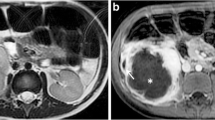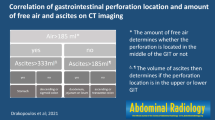Abstract
Purpose
While regarded as a secondary sign of pediatric appendicitis, the frequency of physiologic intra-abdominal fluid in children with suspected but absent appendicitis is unknown.
Ex vivo: to assess the validity of US/MRI measurements of free fluid. In vivo: in suspected pediatric appendicitis, to assess the amount of abdominal fluid by US and MRI, determine performance characteristics of US in fluid detection and identify fluid volume ranges in confirmed appendicitis.
Methods
Ex vivo: criterion validity of US and MRI for fluid volume measurements was tested using tissue-mimicking phantoms filled with different volumes of distilled water. In vivo: all participants from a previous prospective study of suspected appendicitis were evaluated by US; MRI was performed after equivocal USs. Qualitative and quantitative analyses of abdominal fluid and correlation of fluid presence with appendicitis were performed.
Results
Ex vivo: no difference was found between phantom-fluid amount and measured volume using the formula for volume of an ellipsoid for US (P=0.19) or MRI (P=0.08). In vivo: intra-abdominal fluid was present in 212/591 (35.9%) patients; 75/212 patients with fluid (35.4%) had appendicitis, 60 (28.3%) had alternate diagnoses, and 77 (36.3%) had physiologic fluid. Sensitivity and specificity of US for fluid detection were 84% (95% CI 71–93) and 65% (95% CI 52–77), respectively. In children with versus without appendicitis, the respective ranges of fluid volume were 0.7–1148.8 ml and 0.8–318 ml.
Conclusion
The volume of an ellipsoid formula is a valid method for quantifying intra-abdominal fluid. The sole presence of intra-abdominal fluid on US does not support the diagnosis of pediatric appendicitis.





Similar content being viewed by others
References
Rettenbacher T, Hollerweger A, Gritzmann N, Gotwald T, Schwamberger K, Ulmer H, et al (2002). Appendicitis: should diagnostic imaging be performed if the clinical presentation is highly suggestive of the disease? Gastroenterology 123:992–998.
Doria AS, Moineddin R, Kellenberger CJ, et al (2006). US or CT for Diagnosis of Appendicitis in Children and Adults? A Meta-Analysis. Radiology 241:83–94.
Williamson K, Sherman JM, Fishbein JS, Rocker J (2021). Outcomes for Children With a Nonvisualized Appendix on Ultrasound. Pediatr Emerg Care 1;37:e456–e460.
Dibble EH, Swenson DW, Cartagena C, Baird GL, Herliczek TW (2018). Effectiveness of a Staged US and Unenhanced MR Imaging Algorithm in the Diagnosis of Pediatric Appendicitis. Radiology 286:1022–1029.
Dillman JR, Gadepalli S, Sroufe NS, Davenport MS, Smith EA, Chong ST, Mazza MB, Strouse PJ (2016). Equivocal Pediatric Appendicitis: Unenhanced MR Imaging Protocol for Nonsedated Children-A Clinical Effectiveness Study. Radiology 279:216–225.
Mittal MK, Dayan PS, Macias CG, Bachur RG, Bennett J, Dudley NC, Bajaj L, Sinclair K, Stevenson MD, Kharbanda AB (2013). Pediatric Emergency Medicine Collaborative Research Committee of the American Academy of Pediatrics. Performance of ultrasound in the diagnosis of appendicitis in children in a multicenter cohort. Acad Emerg Med 20:697–702.
Simanovsky N, Hiller N, Lubashevsky N, Rozovsky K (2011). Ultrasonographic evaluation of the free intraperitoneal fluid in asymptomatic children. Pediatr Radiol. 41:732–735.
Baqué P, Iannelli A, Dausse F, de Peretti F, Bourgeon A (2005). A new method to approach exact hemoperitoneum volume in a splenic trauma model using ultrasonography. Surg Radiol Anat 27:249–253.
Keshava SN, Gibikote SV, Mohanta A, Poonnoose P, Rayner T, Hilliard P, Lakshmi KM, Moineddin R, Ignas D, Srivastava A, Blanchette V, Doria A (2015). Ultrasound and magnetic resonance imaging of healthy paediatric ankles and knees: a baseline for comparison with haemophilic joints. Haemophilia 21:e210–22.
Trout AT, Towbin AJ, Zhang B (2014). Journal club: the pediatric appendix: defining normal. AJR Am J of Roentgenol 202:936–945.
Sivit CJ, Siegel MJ, Applegate KE, Newman KD (2001). When appendicitis is suspected in children. Radiographics 21:247–62; questionnaire 288–294.
Puylaert JB (1986). Acute appendicitis: US evaluation using graded compression. Radiology 158:355–360.
Johnson AK, Filippi CG, Andrews T, Higgins T, Tam J, Keating D, Ashikaga T, Braff SP, Gallant J (2012). Ultrafast 3-T MRI in the evaluation of children with acute lower abdominal pain for the detection of appendicitis. AJR Am J Roentgenol 198:1424–1430.
Prendergast PM, Poonai N, Lynch T, McKillop S, Lim R (2014). Acute appendicitis: investigating an optimal outer appendiceal diameter cut-point in a pediatric population. J Emerg Med 46:157–164.
Telesmanich ME, Orth RC, Zhang W, Lopez ME, Carpenter JL, Mahmood N, Jadhav SP, Guillerman RP (2016). Searching for certainty: findings predictive of appendicitis in equivocal ultrasound exams. Pediatr Radiol 2016; 46:1539–1545.
Trout AT, Towbin AJ, Fierke SR, Zhang B, Larson DB (2015). Appendiceal diameter as a predictor of appendicitis in children: improved diagnosis with three diagnostic categories derived from a logistic predictive model. Eur Radiol 25:2231–2238.
Rudralingam V, Footitt C, Layton B (2017). Ascites matters. Ultrasound 25:69–79.
Goldberg BB, Clearfield HR, Goodman GA (1973). Ultrasonic determination of ascites. Arch Intern Med 131:217.
Wall SD, Fisher MR, Amparo EG, Hricak H, Higgins CB (1985). Magnetic resonance imaging in the evaluation of abscesses. AJR Am J Roentgenol 144:1217–1221.
Anvari A, Halpern EF, Samir AE (2015). Statistics 101 for Radiologists. Radiographics 35:1789–1801.
Swinscow TDV. Correlation and regression. In: Statistics at Square One ed. 9th. 10 London: BMJ, 1997.
Sistrom CL, Garvan CW (2004). Proportions, odds, and risk. Radiology 230:12–19.
Rodriguez E Jr, Skarecky D, Narula N, Ahlering TE (2008). Prostate volume estimation using the ellipsoid formula consistently underestimates actual gland size. J Urol 179:501–503.
Quigley AJ, Stafrace S (2013). Ultrasound assessment of acute appendicitis in paediatric patients: methodology and pictorial overview of findings seen. Insights Imaging 4(6):741–51.
Neal JT, Monuteaux MC, Rangel SJ, Bachur RG, Barnewolt CE (2021). Does age affect the test performance of secondary sonographic findings for pediatric appendicitis? Pediatr Radiol 51:2018–2026.
Arredondo AR, Wilkinson M, Barber RB, Gilmartin T, Levine MC (2022). Ultrasonographic Evaluation of Physiologic Free Abdominal Fluid in Healthy Children: A Prospective Observational Study. J Ultrasound Med 41:1061–1067.
Matz S, Connell M, Sinha M, Goettl CS, Patel PC, Drachman D (2013). Clinical outcomes of pediatric patients with acute abdominal pain and incidental findings of free abdominal fluid on diagnostic imaging. J Ultrasound Med 32:1547–1553
Tadayoni A, Farhadi F, Mirmomen SM, Shafiei A, Berman KF, Bagheri M, Martinez PE, Schmidt PJ, Yanovski JA, Malayeri AA (2019). Evaluation of incidental pelvic fluid in relation to physiological changes in healthy pubescent children using pelvic magnetic resonance imaging. Pediatr Radiol 49:784–790.
Ormsby EL, Geng J, McGahan JP, Richards JR (2005). Pelvic free fluid: clinical importance for reproductive age women with blunt abdominal trauma. Ultrasound Obstet Gynecol 26:271–278.
Harvey CJ, Pilcher JM, Eckersley RJ, Blomley MJ, Cosgrove DO (2002). Advances in ultrasound. Clin Radiol 57:157-177.
Carpenter JL, Orth RC, Zhang W, Lopez ME, Mangona KL, Guillerman RP (2017). Diagnostic Performance of US for Differentiating Perforated from Nonperforated Pediatric Appendicitis: A Prospective Cohort Study. Radiology 282:835–841.
Tulin-Silver S, Babb J, Pinkney L, Strubel N, Lala S, Milla SS, Tomita S, Fefferman NR (2015). The challenging ultrasound diagnosis of perforated appendicitis in children: constellations of sonographic findings improve specificity. Pediatr Radiol 45:820–830.
Riedesel EL, Weber BC, Shore MW, Cartmill RS, Ostlie DJ, Leys CM, Gill KG, Kohler JE (2019). Diagnostic performance of standardized ultrasound protocol for detecting perforation in pediatric appendicitis. Pediatr Radiol 49:1726–1734.
Acknowledgements
Rahim Moineddin for his support in the statistical analysis discussions.
Funding
This study was funded by the Physicians’ Services Incorporated (PSI), Dr. Doria as Principal Investigator (PI) and Dr. Schuh as Co-PI.
Author information
Authors and Affiliations
Corresponding author
Ethics declarations
Conflict of interest
Authors are required to disclose financial or non-financial interests that are directly or indirectly related to the work submitted for publication. Andrea S. Doria has had, during the past 3 years, the following relationships unrelated to this work. Research Support: Baxalta-Shire (Research Grant), Novo Nordisk (Research Grant), Terry Fox Foundation (Research Grant), Society of Pediatric Radiology (Research Grant), Garron Family Cancer Centre (Research Grant).
Informed consent
Waiver of patient informed consent was obtained for this retrospective study.
Additional information
Publisher's Note
Springer Nature remains neutral with regard to jurisdictional claims in published maps and institutional affiliations.
Rights and permissions
Springer Nature or its licensor (e.g. a society or other partner) holds exclusive rights to this article under a publishing agreement with the author(s) or other rightsholder(s); author self-archiving of the accepted manuscript version of this article is solely governed by the terms of such publishing agreement and applicable law.
About this article
Cite this article
Rodriguez-Takeuchi, S., Sousa-Plata, K., Man, C. et al. Characterization and quantification of fluid in the abdomen by ultrasound and magnetic resonance imaging in children with clinical suspicion of appendicitis. Abdom Radiol 49, 1031–1041 (2024). https://doi.org/10.1007/s00261-023-04133-3
Received:
Revised:
Accepted:
Published:
Issue Date:
DOI: https://doi.org/10.1007/s00261-023-04133-3




